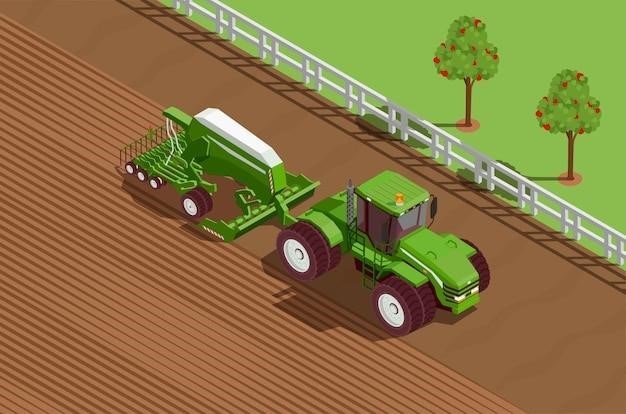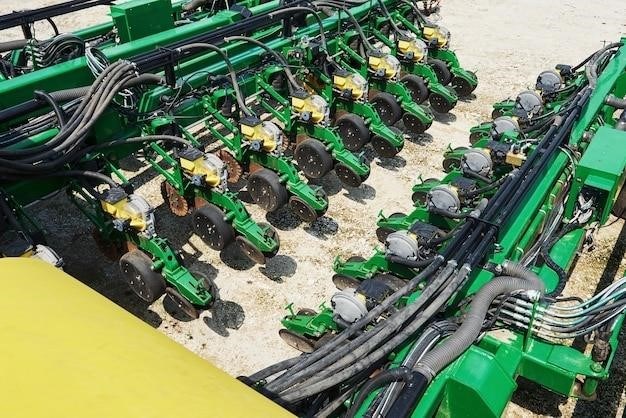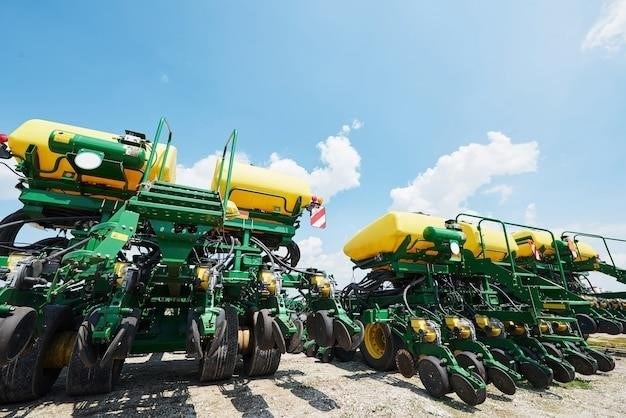John Deere 7000 Planter⁚ A Comprehensive Manual Guide
This manual provides essential information for the successful operation and maintenance of your John Deere 7000 planter. From pre-planting checks to post-planting care, this guide ensures optimal planting performance and crop yields. Master your planter’s capabilities with this detailed resource.
The John Deere 7000 series planter represents a significant advancement in planting technology, designed to optimize planting precision and efficiency across a range of field conditions and crops. This versatile planter boasts a robust build, incorporating high-quality components for long-lasting durability and reliable performance. Its advanced features are geared towards maximizing yield potential by ensuring consistent seed placement, depth control, and fertilizer distribution. Understanding the intricacies of this planter is key to unlocking its full potential and achieving optimal planting results.
The 7000 series offers various configurations, allowing farmers to customize their planter to suit their specific needs and acreage; These configurations encompass different row units, fertilizer systems, and monitoring technologies. This adaptability ensures the planter’s suitability for various farming operations, from small-scale to large-scale agricultural enterprises. The planter’s intuitive design makes operation relatively straightforward, but a thorough understanding of its features and functionalities is crucial for optimal performance. This manual will serve as your comprehensive guide to mastering the John Deere 7000 planter, helping you achieve maximum efficiency and yield in your planting operations.
Proper maintenance and regular inspections are integral to the longevity and performance of your John Deere 7000 planter. Consistent upkeep will ensure the planter continues to operate smoothly and accurately, contributing to higher yields and minimizing downtime during the crucial planting season. This manual will not only help you operate the planter but also provide guidance on maintaining its peak performance and preventing potential issues.

II. Pre-Planting Preparations
Before commencing planting operations with your John Deere 7000 planter, a thorough pre-planting preparation is crucial to ensure optimal performance and accurate seed placement. This phase involves a series of critical checks and adjustments to guarantee the planter is in peak condition. Neglecting this crucial step can lead to inconsistencies in planting depth, spacing, and overall yield. Begin by carefully inspecting the entire planter for any signs of damage or wear and tear from previous seasons; Pay close attention to the row units, seed tubes, fertilizer system components, and the planter’s overall structural integrity.
Check all fluid levels, including hydraulic oil and lubricating fluids, ensuring they are within the recommended ranges. Inspect the planter’s belts and chains for any signs of wear, fraying, or damage. Replace worn or damaged components immediately to prevent potential malfunctions during planting. Clean the planter thoroughly, removing any accumulated debris, soil, or plant matter that may hinder its proper functioning. Ensure all sensors, gauges, and electronic components are properly connected and functioning correctly. This comprehensive inspection will identify any potential issues before they escalate into major problems during the planting process.
Thorough pre-planting preparation not only prevents potential issues but also enhances the overall efficiency and accuracy of your planting operation. By addressing any problems proactively, you will maximize yield potential and minimize costly delays. Investing time in this vital phase will ultimately contribute to a successful planting season and a bountiful harvest.
II.A. Inspecting the Planter
A meticulous inspection of your John Deere 7000 planter is paramount before commencing any planting operations. This comprehensive check ensures the planter’s components are in optimal working order, preventing potential issues that could compromise planting accuracy and yield. Begin by visually examining the entire planter for any signs of damage, wear, or loose components. Pay close attention to the row units, carefully checking for bent or broken parts, ensuring all bolts and nuts are securely tightened. Inspect the seed tubes for any cracks or blockages that could impede seed flow. Examine the fertilizer system, checking for leaks or damage to hoses and lines.
Next, focus on the planter’s wheels and tires, verifying proper inflation and checking for any signs of wear or damage. Inspect the planter’s frame and hitch for any signs of bending or stress. Carefully examine the planter’s markers and depth gauge wheels, ensuring they are properly adjusted and functioning correctly. Check the condition of the planter’s belts and chains, replacing any worn or damaged components immediately. Don’t overlook the electrical system; inspect all wiring harnesses and connectors for any signs of damage or corrosion. Test all lights and operational indicators to confirm their functionality.
This thorough inspection ensures the planter is ready for optimal performance; Addressing any identified issues proactively prevents costly downtime and ensures a successful planting season. Remember, a well-maintained planter is key to achieving high yields and maximizing your investment.
II.B. Calibration and Adjustments
Accurate calibration and precise adjustments are crucial for optimal performance of your John Deere 7000 planter. Before planting, calibrate the planter to ensure accurate seed spacing and planting depth. Begin by measuring the ground speed using a calibrated GPS device or by marking a known distance and timing the planter’s travel. Consult your planter’s operator’s manual for specific instructions on adjusting the ground wheel drive for accurate ground speed readings. Once the ground speed is established, adjust the planter’s seed metering mechanism to achieve the desired seed population per acre.
This involves making adjustments to the seed plates or metering rollers, depending on the planter’s configuration. Use the provided calibration charts to determine the appropriate settings for your chosen seed type and desired planting rate. After making adjustments, run a test planting to verify accuracy. Collect and count the seeds from several rows to ensure consistent seed distribution. Fine-tune the settings as needed to achieve the target seed population. Next, adjust the planter’s depth gauge wheels to achieve the desired planting depth. This is crucial for optimal seed germination and seedling emergence.
Pay close attention to the soil conditions and adjust the depth accordingly. After completing the calibration and adjustments, conduct a thorough visual inspection to ensure all components are functioning correctly and securely fastened. Thorough calibration and precise adjustments minimize waste, optimize yields, and ensure a successful planting season. Refer to the specific calibration charts and instructions detailed in your planter’s manual for detailed step-by-step guidance.
III. Planting Procedures
Efficient and effective planting procedures are vital for maximizing yields with your John Deere 7000 planter. Before commencing planting, ensure the planter is properly calibrated and adjusted (as detailed in Section II.B). Begin by filling the seed hoppers with the selected seed type. Handle seeds carefully to avoid damage or breakage. Always check seed quality and viability before planting. Ensure the seed is free from debris or contaminants. Inspect the seed tubes for any obstructions that may hinder the smooth flow of seeds. Clean any debris or foreign material from the seed tubes to ensure uniform seed distribution. Monitor the seed flow during planting to promptly address any issues.
Maintain a consistent ground speed throughout the planting process. Avoid sudden acceleration or deceleration, as this can affect planting depth and seed spacing; Pay close attention to the planter’s performance indicators, such as seed spacing and planting depth gauges. Make any necessary adjustments as needed to maintain optimal planting conditions; Regularly check for any signs of malfunction or damage to the planter components. Address any issues promptly to avoid compromising planting accuracy. Observe the field conditions and make adjustments to planting depth based on soil moisture and texture. Proper soil conditions influence seed-to-soil contact and germination.

After completing the planting operation, conduct a thorough post-planting inspection of the planted field to check for any irregularities in seed spacing or planting depth. Document any issues encountered during the planting process to aid in troubleshooting and future improvements. Adhering to these procedures ensures a successful planting season and maximizes the potential of your John Deere 7000 planter. Remember, consistent monitoring and timely adjustments are key to achieving optimal planting results.
III.A. Seed Selection and Handling
Proper seed selection and handling are paramount for successful planting with your John Deere 7000 planter. Begin by choosing high-quality seeds from reputable suppliers. Ensure the seed variety is appropriate for your soil type, climate, and intended planting date. Check the seed’s germination rate and vigor to ensure optimal planting success. Seeds with low germination rates will significantly impact yield and crop uniformity. Before planting, inspect the seeds for any signs of damage, disease, or insect infestation. Discard any seeds that show signs of damage or abnormalities; Inspect the seeds for proper moisture content; overly dry or damp seeds can negatively affect germination.
Store seeds in a cool, dry, and well-ventilated area to maintain their viability. Avoid storing seeds in direct sunlight or in locations with extreme temperature fluctuations. Use appropriate seed handling equipment to prevent damage during the planting process. Handle seeds gently to avoid crushing or breaking. Avoid prolonged exposure to moisture or high temperatures, as this can reduce seed viability. For best results, plant seeds within the recommended timeframe for your chosen variety. This will ensure optimal germination and growth.
Consider using seed treatments to protect against diseases and pests. Seed treatments can improve seedling establishment and increase overall crop yield. Always follow the manufacturer’s instructions when using seed treatments. Accurate seed selection and proper handling are crucial steps in maximizing the productivity of your John Deere 7000 planter. These practices contribute significantly to achieving high yields and a successful harvest.
III.B. Planting Depth and Spacing
Achieving optimal planting depth and spacing is critical for maximizing yields with your John Deere 7000 planter. Planting depth significantly impacts seed germination and seedling emergence. Too shallow, and seeds may be vulnerable to desiccation or predation; too deep, and seedlings may struggle to reach the surface. The ideal planting depth varies depending on the seed type, soil conditions, and environmental factors. Consult your seed supplier’s recommendations for optimal depth. Use the planter’s depth adjustment mechanisms to fine-tune planting depth according to field conditions. Regularly monitor planting depth throughout the planting process, making adjustments as needed to maintain consistency.
Consistent seed spacing is equally important for maximizing yield potential. Proper spacing allows for optimal nutrient and water uptake, reduces competition between plants, and ensures uniform growth. The ideal spacing depends on the crop type and variety. Your John Deere 7000 planter offers adjustable mechanisms to control seed spacing. Utilize the planter’s calibration features to ensure accurate seed spacing. Regularly check seed spacing during planting to identify and correct any inconsistencies. Ensure the seed metering mechanism is functioning correctly and that the seed tubes are properly aligned. Inconsistent spacing can lead to uneven plant growth and reduced yields.
Factors like soil compaction and moisture content can affect planting depth and spacing. Adjust the planter settings as necessary to account for variations in soil conditions across the field. Properly calibrated planting depth and spacing contribute significantly to maximizing the efficiency and productivity of your John Deere 7000 planter, leading to a successful harvest.
IV. Maintenance and Troubleshooting
Regular maintenance is crucial for the longevity and optimal performance of your John Deere 7000 planter. After each planting season, a thorough cleaning is essential. Remove all soil, debris, and seed residue from the planter components. Inspect all moving parts for wear and tear, paying close attention to bearings, chains, and belts. Replace worn or damaged parts promptly to prevent further issues. Lubricate all moving parts according to the manufacturer’s recommendations. Use the appropriate lubricants to ensure smooth operation and prevent premature wear. Store the planter in a dry, clean environment to protect it from the elements.
Troubleshooting common problems is a key aspect of planter maintenance. If you encounter issues with seed metering, check the seed metering mechanism for obstructions or damage. Ensure the seed tubes are properly aligned and free from blockages. If planting depth is inconsistent, verify the depth adjustment mechanisms are functioning correctly and make necessary adjustments. Pay close attention to the planter’s warning indicators and address any issues promptly. Refer to the John Deere 7000 planter’s troubleshooting guide for assistance with specific problems. If you’re unable to resolve an issue, contact a qualified John Deere technician for professional assistance.
Preventative maintenance is more cost-effective than reactive repairs. A well-maintained planter ensures consistent planting performance, minimizes downtime, and extends the planter’s lifespan. Regular inspections, cleaning, and lubrication are key to maximizing the return on your investment. Proper maintenance ensures you’re ready for the next planting season, maximizing your efficiency and yield.

No Responses